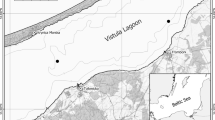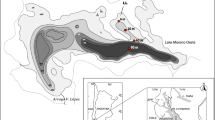Abstract
Two opposite distribution patterns of larval Glyptotendipes paripes in relation to organic carbon content in sediments of central Florida lakes were discovered. In a majority of examined lakes, G. paripes larvae were most abundant in sand sediment and their density rapidly declined with increased carbon content (type 1 lakes); however, in some cases the opposite was true (type 2 lakes). To elucidate this anomaly, field-collected organic sediments from types 1 and 2 lakes and sand sediment were studied for G. paripes development in the laboratory. Type 1 organic sediment consisted predominantly of fine particles (<0.25 mm diameter) with low dissolved oxygen levels, whereas type 2 organic sediments consisted primarily of chironomid large faecal pellet aggregates (>0.25 mm diameter), with significantly higher levels of dissolved oxygen concentrations that were similar to sand sediment. Type 2 organic sediment and sand sediment were conducive to higher survival of G. paripes larvae than fine organic sediment. The larvae in type 2 organic sediment produced longer tubes than in other sediment types. This observation indicates that accumulation of chironomid faecal pellets in lake sediments may change physical properties, such as dissolved oxygen level and consequently alter conditions for survival of chironomid larvae and possibly other benthic fauna.
Similar content being viewed by others
References
Ali, A., 1989. Chironomids, algae, and chemical nutrients in a lentic system in central Florida USA. Acta Biologica Debrecina Oecologica Hungarica 3: 15–27.
Ali, A., 1995. Nuisance, economic impact and possibilities for control. In Armitage, P. D., P. S. Cranston & L. C. V. Pinder (eds), The Chironomidae: The Biology and Ecology of Non-Biting Midges. Chapman and Hall, London: 339–364.
Ali, A. 1996. Pestiferous Chironomidae and their management. In Rosen, D., F. D. Bennett & J. L. Capinera (eds), Pest Management in the Subtropics: Integrated Pest Management-A Florida Perspective. Intercept, Andover: 487–513.
Ali, A., J. Frouz & R. J. Lobinske, 2002. Spatio-temporal effects of selected physico-chemical variables of water, algae and sediment chemistry on the larval community of nuisance Chironomidae (Diptera) in a natural and a man-made lake in central Florida. Hydrobiologia 470: 181–193.
Ali, A., R. J. Lobinske & P. K. Chaudhuri, 1996. Long-term (1980-94) population trends of pestiferous Chironomidae (Diptera) along a lakefront in central Florida. Journal of the American Mosquito Control Association 12: 106–111.
Ali, A., B. H. Stanley & P. K. Chaudhuri, 1986. Attraction of some adult midges (Diptera: Chironomidae) of Florida to artificial light in the field. Florida Entomologist 69: 644–650.
Ali, A., B. H. Stanley & S. R. Stafford, 1983. Short-term daily emergence of adult midges (Diptera: Chironomidae) from a natural lake and an artificial reservoir. Environmental Entomology 12: 765–767.
Bradley, W. H. & M. E. Beard, 1969. Mud Lake Florida, its algae and alkaline brown water. Limnology and Oceanography 14: 889–897.
Brotas, V., A. Amorim-Ferreira, C. Vale & F. Catarino, 1990. Oxygen profiles in intertidal sediments of Ria Formosa (S. Portugal). Hydrobiologia 207: 123–129
Cowell, B. C., C. W. Dye & R. C. Adams, 1975. A synoptic study of the limnology of Lake Thonotosassa, Florida. Part 1. Effects of primary treated sewage and citrus wastes. Hydrobiologia 46: 301–345.
Datta, S. & B. B. Jana, 1997. Influence of chironomid larvae Chironomus sp., on phosphate release from rock phosphate fertilized soil water system. Journal of Applied Aquaculture 7: 31–39.
Environmental Protection Agency, 1978. A Compendium of Lake and Reservoir Data Collected by the National Eutrophication Survey in Eastern North-Central, and Southeastern United States, United States Environmental Protection Agency, Corvallis Environmental Research Laboratory, Corvallis, OR. PB-289 820.
Håkanson, L. & M. Jansson, 1983. Principles of Lake Sedimentology. Springer-Verlag, Berlin, Heidelberg, New York, Tokyo.
Heinis, F. & C. Davis, 1993. Factors governing the spatial and temporal distribution of chironomid larvae in the Maarsseveen lakes with special emphasis on the role of oxygen conditions. Netherlands Journal of Aquatic Ecology 27: 21–34.
Heinis, F., J. P. Sweerts & E. Lopick, 1994. Micro environment of chironomid larvae in the littoral and profundal zones of the Maarsseveen I, The Netherlands. Archiv für Hydrobiologie 130: 53–67.
Hirabayashi, K. & R. S. Wotton, 1998. Organic matter processing by chironomid larvae (Diptera: Chironomidae). Hydrobiologia 382: 151–159.
Iovino, A. J. & W. H. Bradley, 1969. The role of larval Chironomidae in the production of lacustrine copropel in Mud Lake, Marion County, Florida. Limnology and Oceanography 14: 898–905.
Jackson, M. L., 1958. Soil Chemical Analysis. Prentice Hall, Inc., Englewood Cliffs, NY.
Johannsson, O. E., 1980. Energy dynamics of eutrophic chironomid Chironomus plumosus f. semireductus from the bay of Quinte, Lake Ontario. Canadian Journal of Fisheries and Aquatic Sciences 37: 1254–1265.
Kajan, R. & P. Frenzel, 1999. The effect of chironomid larvae on production, oxidation and fluxes of methane in a flooded rice soil. FEMS-Microbial-Ecology 28: 121–129.
Lavelle, P., D. Bignell & M. Lepage, 1998. Soil Function in a changing world: The role of invertebrate ecosystem engineers. European Journal of Soil Biology 33: 15–193.
Lobinske, R. J., 2001. Ecological studies of larval Glyptotendipes paripes (Chironomidae: Diptera) in selected central Florida lakes for creating an exploratory temporal and spatial model of nuisance populations. Ph.D. dissertation. University of Florida, Gainesville, FL.
Lobinske, R. J., A. Ali & J. Frouz, 2002. Ecological studies of spatial and temporal distributions of larval Chironomidae (Diptera) with emphasis on Glyptotendipes paripes in three central Florida lakes. Environmental Entomology 31: 637–647.
Martin, J. C., C. Kuvangkadilok, D. H. Peart & B. T. O. Lee, 1980. Multiple sex determining regions in a group of related Chironomus species (Diptera: Chironomidae). Heredity 44: 367–382.
Martin, P., L. Granina, K. Martens & B. Goddeeris, 1998. Oxygen concentration profiles in sediments of two ancient Lakes: Lake Baikal (Siberia, Russia) and Lake Malawi (East Africa). Hydrobiologia 367: 163–174.
Matisoff, G. & X. Wang, 2000. Particle mixing by freshwater infaunal bioirrigators: midges (Chironomidae: Diptera) and may-flies (Ephemeridae: Ephemeroptera). Journal of Great Lakes Research 26: 174–182.
McLachlan, A. J., 1976. Factors restricting the range of Glyptotendipes paripes Edwards (Diptera: Chironomidae) in bog lake. Journal of Animal Ecology 45: 105–113.
Osborne, S., S. Hurrell, K. Simki & A. Lied, 2000. Factors influencing the distribution and feeding of the larvae of Chironomus riparius. Hydrobiologia 94: 67–73.
Pinder, L. C. V., 1995. Biology of the eggs and first-instar larvae. In Armitage, P. D., P. S. Cranston & L. C. V. Pinder (eds), The Chironomidae: The Biology and Ecology of Non-Biting Midges. Chapman and Hall, London: 87–106.
Provost, M. W., 1957. The Production of Chironomids in the Lakes of the Winter Haven Area. Preliminary Study. Florida State Board of Health, Tallahassee, Florida.
Rasmussen, J. B., 1984. The life history, distribution, and production of Chironomus riparius and Glyptotendipes paripes in prairie pond. Hydrobiologia 119: 65–72.
Rasmussen, J. B., 1985. Effects of density and microdetritus enrichment on growth of chironomid larvae in small pond. Canadian Journal of Fisheries and Aquatic Sciences 42: 1418–1422.
Stevens, M. M., 1998. Development and survival of Chironomus tepperi Skuse (Diptera: Chironomidae) at a range of constant temperatures. Aquatic Insects 20: 181–188.
Svensson, J. M., 1998. Emission of N2O, nitrification and denitrification in a eutrophic lake sediment bioturbed by Chironomus plumosus. Aquatic Microbiology and Ecology 14: 289–299.
Wotton, R. S. & K. Hirabayashi, 1999. Midge larvae (Diptera: Chironomidae) as engineers in slow sand filter beds. Water Research 33: 1509–1515.
Wotton, R. S. & B. Malmqvist, 2001. Feces in aquatic ecosystems. Bioscience 51: 537–544.
Author information
Authors and Affiliations
Rights and permissions
About this article
Cite this article
Frouz, J., Lobinske, R.J. & Ali, A. Influence of Chironomidae (Diptera) faecal pellet accumulation on lake sediment quality and larval abundance of pestiferous midge Glyptotendipes paripes . Hydrobiologia 518, 169–177 (2004). https://doi.org/10.1023/B:HYDR.0000025066.62554.7e
Issue Date:
DOI: https://doi.org/10.1023/B:HYDR.0000025066.62554.7e




